
Climate change is affecting the entire world, but not all countries are affected equally. Each year, Germanwatch, an environmental organization that promotes global sustainability and equity, lists the 10 countries most affected by extreme weather events for the reporting year as well as the 10 countries most affected over the previous two decades.
The persistent message from the reports is that extreme weather events are becoming more frequent and more damaging as a result of climate change. A second message is that poor countries are overwhelmingly the most consistent and hard-hit victims. (Landmarks are not immune to the ravages of climate change. These are natural landmarks already damaged or destroyed by climate change.)
To find 20 countries that are most affected by climate change, 24/7 Wall St. reviewed Germanwatch’s Global Climate Risk Index 2021 as well as previous reports. The CRI measures and analyzes the effects of climate from extreme weather events.
Many poorer countries tend to have a natural vulnerability to the ravages of extreme weather because of their geography and topography. In addition, their less resiliently-built environments further exacerbate their vulnerability. They are also least able to protect themselves from harm and recover from damage. Eight out of 10 of the most impacted countries in 2019 (as listed in the 2021 report) are low- to low-middle- income countries. Half of the countries are considered to be among the least developed economies in the world.
Ironically, the countries suffering the most are also the ones contributing the least to the climate crisis. The 10 countries on the most affected list contributed 2.21% of the world’s total greenhouse gas emissions in 2020. In the same year, the population of those countries totaled over 695 million, 8.95% of the world’s population. (These are the 20 countries responsible for nearly all global emissions.)
These facts were widely discussed at last November’s climate summit in Glasgow, with the leaders of the world’s poorest and most vulnerable nations pleading for fairness and assistance in the global struggle with global warming.
Click here to see the countries where climate change is most evident
Click here to read our detailed methodology

Puerto Rico
> 2020 CO2 emissions: 3.96 million metric tons
> Share of global emissions: 0.01%
> Population: 3,194,030
Puerto Rico is particularly subject to flooding and regularly suffers from persistent Caribbean and Atlantic storms, and these are becoming more frequent and disastrous. According to Germanwatch, Puerto Rico was the country most affected by climate change in the two decades between 1999 and 2018. By far, most of the damage wrought in that period – 98% – was caused by Hurricane Maria in 2017. Thousands of lives were lost and the Island incurred at least $90 billion in damages.
[in-text-ad]

Myanmar
> 2020 CO2 emissions: 37.71 million metric tons
> Share of global emissions: 0.10%
> Population: 54,409,790
In the 20 years between 1999 and 2018, Myanmar was pummeled with 57 extreme weather events – cyclones, storm surges, extreme temperatures – costing $3 billion in direct damages and the loss of 141,129 lives. This does not include the high costs of the droughts resulting from extreme heat, the displacement caused by flooding, or other longer term, indirect impacts of extreme weather.
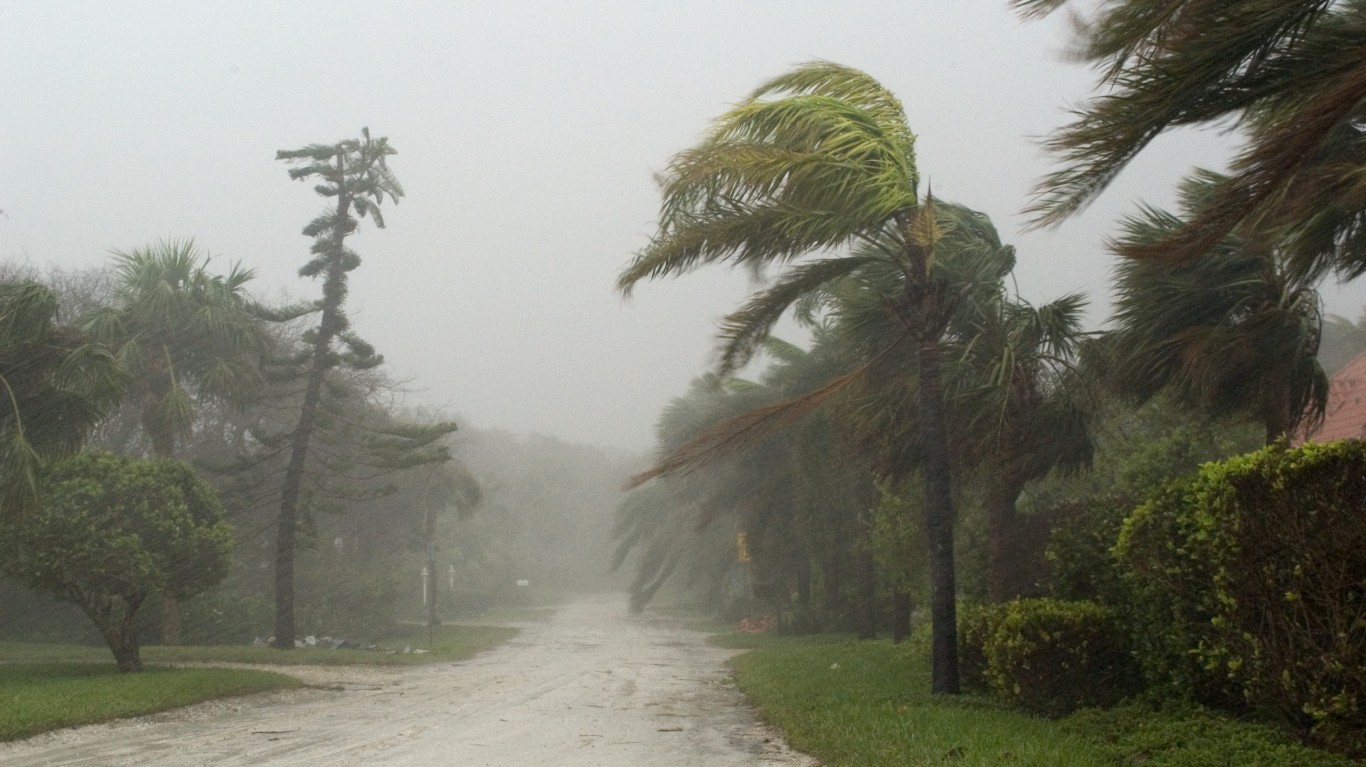
Haiti
> 2020 CO2 emissions: 3.01 million metric tons
> Share of global emissions: 0.01%
> Population: 11,402,530
In the past decades, Haiti’s temperature has risen and the rains have become less predictable and more damaging, even as storms have become more frequent and intense. Floods, droughts, and salt intrusion from storm surges are already affecting Haiti’s economy. Haiti is Latin America’s most vulnerable nation from a climate perspective, with its fragility made more so by historic deforestation and poverty.
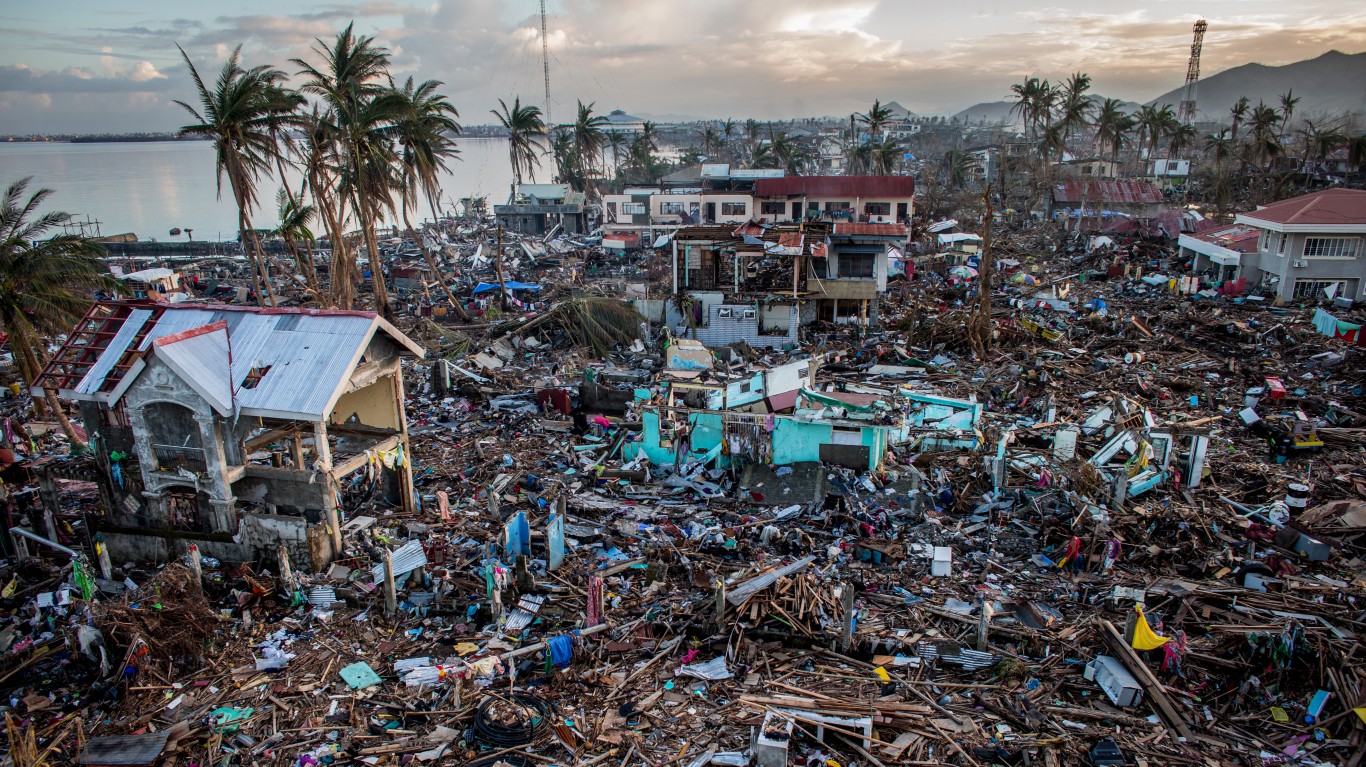
Philippines
> 2020 CO2 emissions: 139.16 million metric tons
> Share of global emissions: 0.39%
> Population: 109,581,090
The Philippines is one of the countries most vulnerable to climate change due in large part to its long coastline, large floodplains, and Pacific location. In recent years, it has experienced erratic weather patterns and more damaging storms, causing deadly droughts, floods, and landslides. In December of 2021, a Category 5 typhoon, Rai, killed 400 people and destroyed or damaged 925,000 homes. Cleanup efforts are expected to take up to six months.
[in-text-ad-2]

Mozambique
> 2020 CO2 emissions: 9.94 million metric tons
> Share of global emissions: 0.03%
> Population: 31,255,440
Mozambique is particularly vulnerable to cyclones and flooding, dangers that are increasing with climate change. Following two deadly cyclones in 2019, Idai and Kenneth, and with much of its damaged infrastructure still in need of repair, Mozambique was slammed again in early January of 2021 by yet another cyclone. Eloise destroyed 56,000 homes and undid much of the recovery work from the earlier storms.
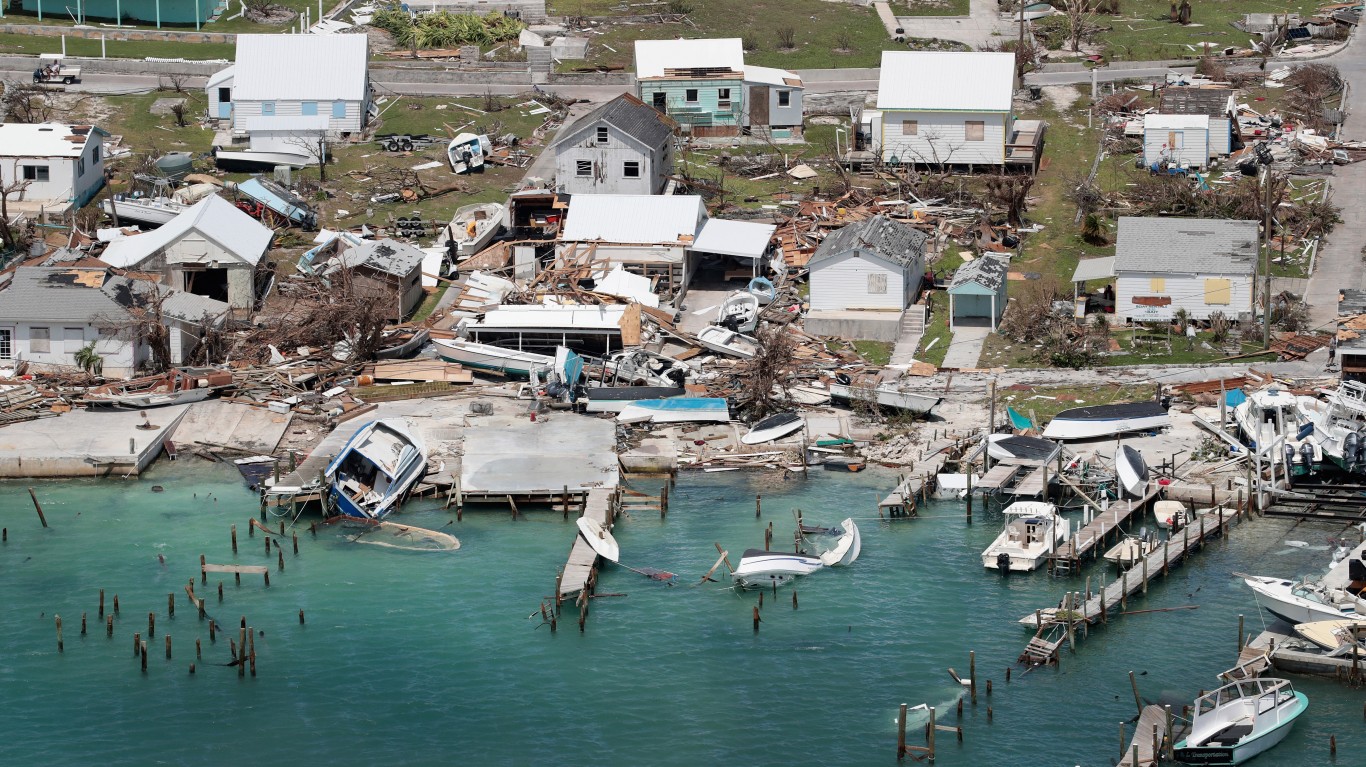
Bahamas
> 2020 CO2 emissions: 1.89 million metric tons
> Share of global emissions: 0.01%
> Population: 393,250
The greatest weather event threat to the Bahamas is and has been hurricanes, but climate change has upped the ante. In 2019, Hurricane Dorian was the most dangerous hurricane to hit the region, wallopping the Bahamas with 185 mph winds and dumping 36 inches of rain in a matter of hours. Seventy-four people were killed, and damages amounted to $3.4 billion. Almost half the houses on two of the islands were damaged or destroyed.
[in-text-ad]
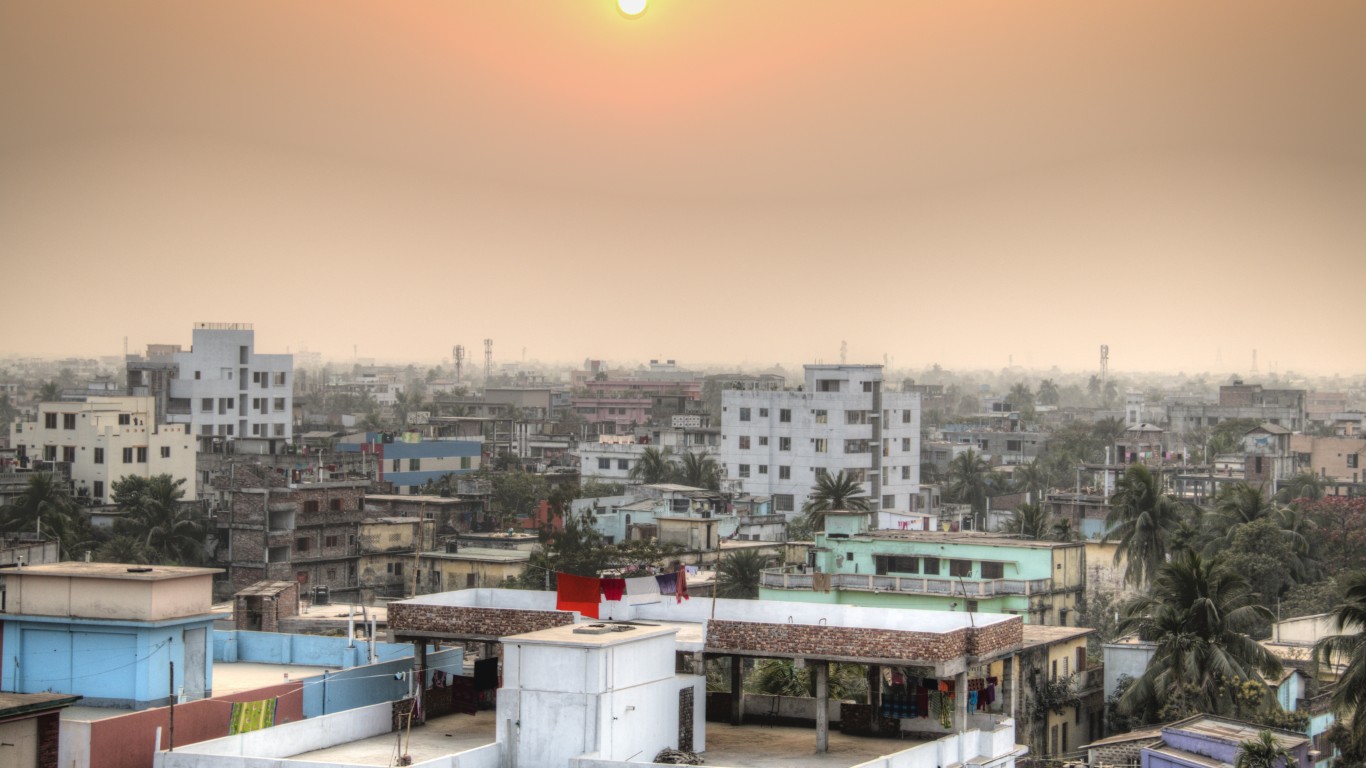
Bangladesh
> 2020 CO2 emissions: 108.5 million metric tons
> Share of global emissions: 0.30%
> Population: 164,689,380
Climate change will cause the largest mass migration in human history, and it has already begun in Bangladesh. Almost one-quarter of the country is less than 6 feet above sea level, and most people live in the coastal plains where farmers benefit from the rich delta soils. Every year, a large portion of the country is inundated by flooding, 60% after a major storm. Entire villages have been forced to move inland due to sea level rise and flooding.
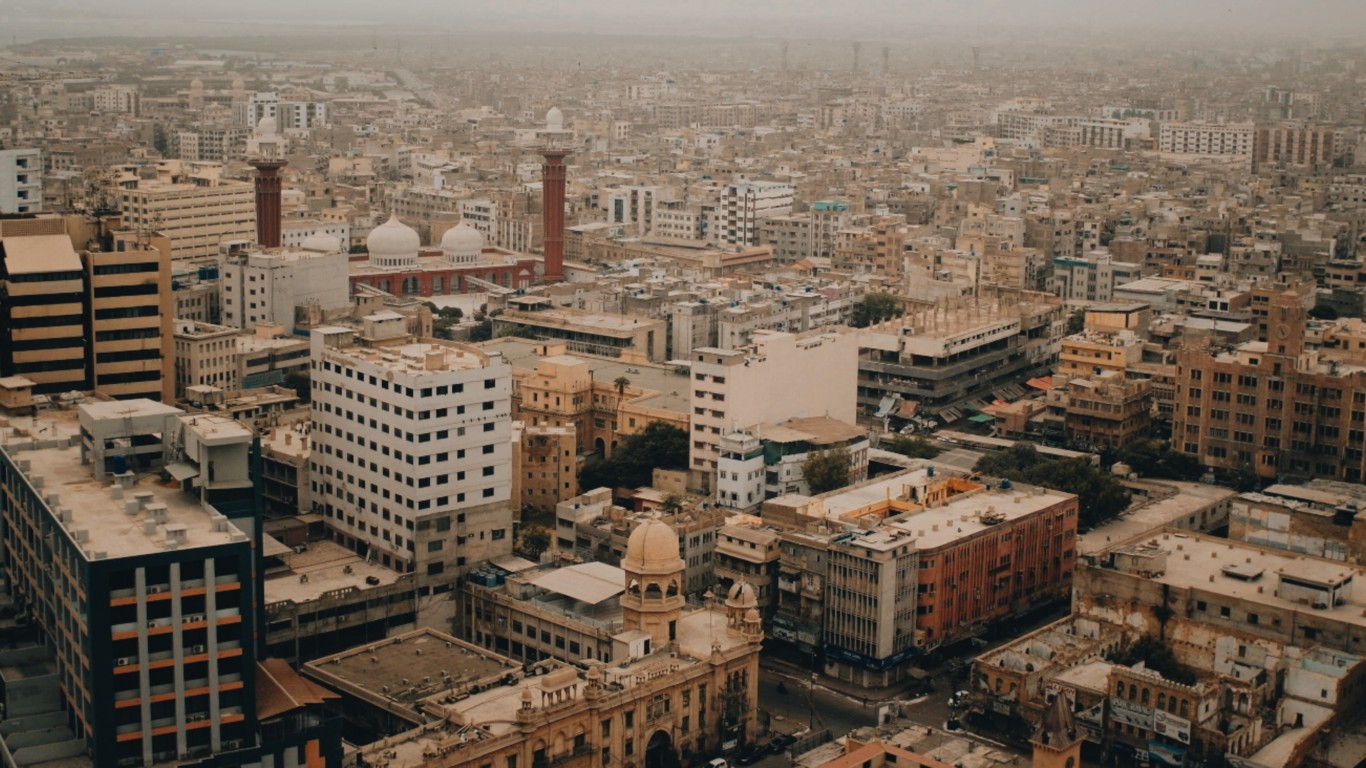
Pakistan
> 2020 CO2 emissions: 217.02 million metric tons
> Share of global emissions: 0.60%
> Population: 220,892,330
Pakistan is suffering from several impacts of climate change. Melting glaciers are causing floods and depriving the country of fresh water reserves; sea level rise is threatening the coastlines; and temperatures are becoming “too hot for human tolerance,” according to nonprofit Climate Refugees. In the summer of 2021, the temperature reached 126 degrees Fahrenheit in Jacobabad.
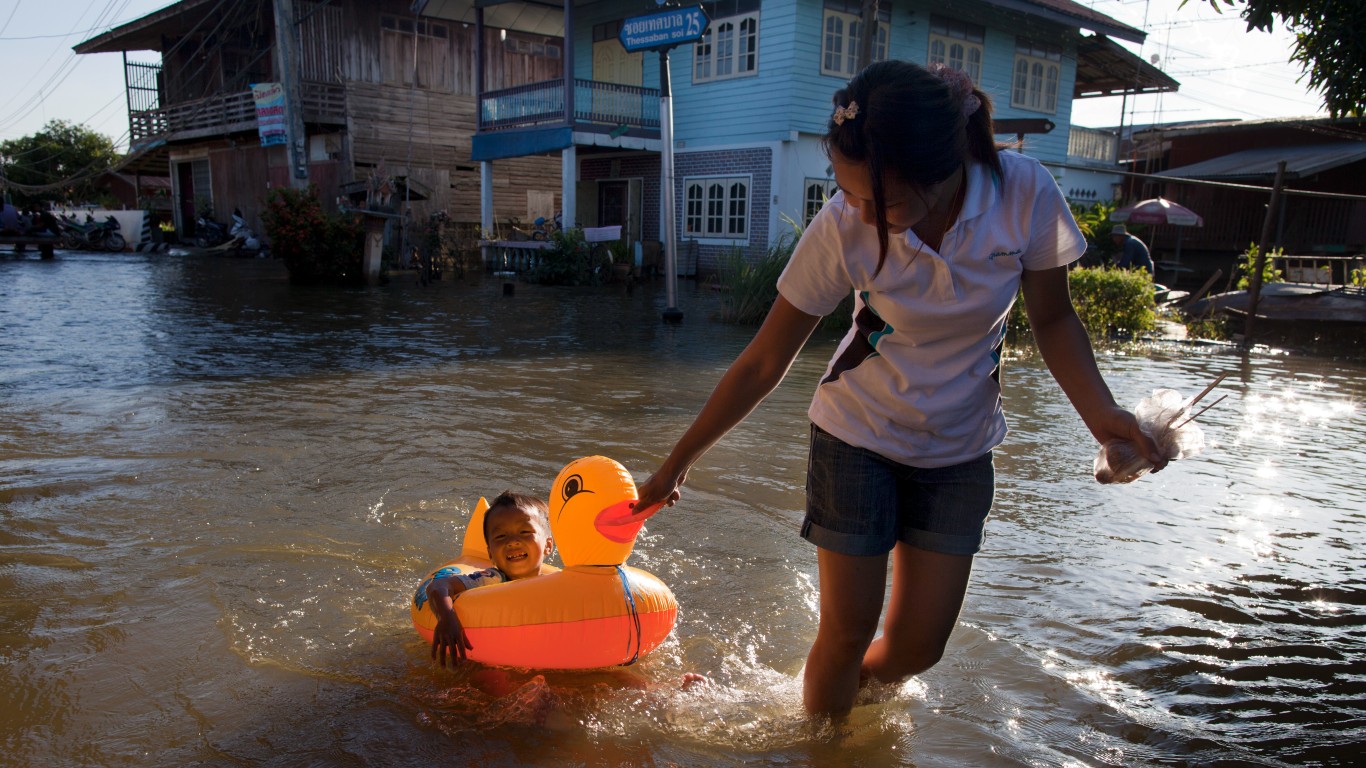
Thailand
> 2020 CO2 emissions: 255.46 million metric tons
> Share of global emissions: 0.71%
> Population: 69,799,980
Thailand has been experiencing the effects of climate change for decades, with rising temperatures, changing weather patterns, and diminishing precipitation, leading to alternating floods and droughts. The greatest damage lies in the future, with sea level rising faster than the global average. There is talk of moving the capital from its current location because Bangkok, which is also sinking from its own weight, is only 5 feet above current sea level.
[in-text-ad-2]

Nepal
> 2020 CO2 emissions: 17.89 million metric tons
> Share of global emissions: 0.05%
> Population: 29,136,810
In July of 2021, while its delegates were preparing their presentations for the climate summit in Glasgow, intense monsoon rains killed 50 people and washed away valuable infrastructure across Nepal. The event, and the greater picture of melting glaciers, erratic precipitation patterns, floods, and droughts that are ruining farms and displacing people, was a reminder for summit participants of the devastation that climate change is wreaking in the world’s poorest countries.
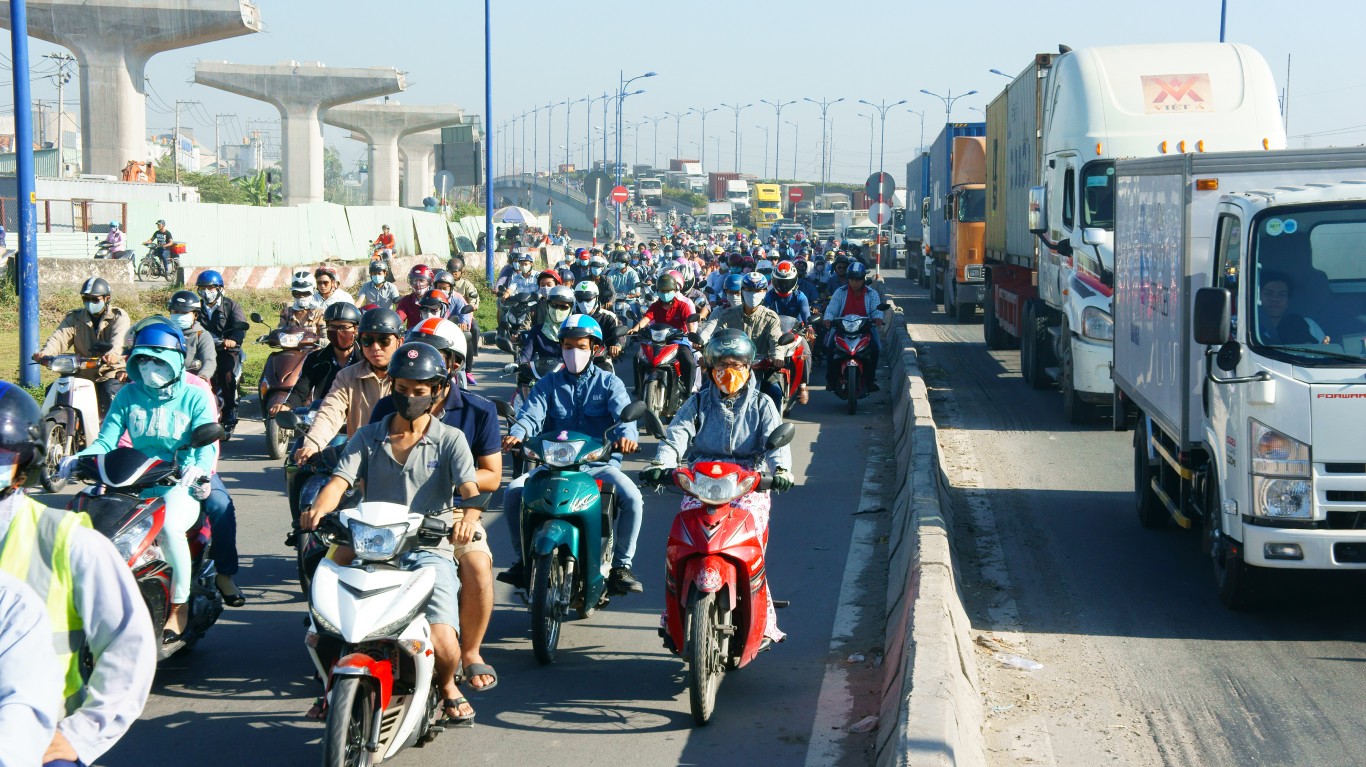
Vietnam
> 2020 CO2 emissions: 321.93 million metric tons
> Share of global emissions: 0.90%
> Population: 97,388,580
Vietnam was listed in the Germanwatch 2020 climate report as one of the 10 countries most affected by climate change in the decades between 1999 and 2018. The Climate Risk Index report for 2019 described the climate-charged weather events that afflicted the country in a single year, 2017. April storms destroyed infrastructure and thousands of houses; in the summer, two tropical storms killed 15 people; in November, a typhoon and the floods that followed killed another 100 people; and before the year ended, Typhoon Damrey destroyed water supplies and damaged 80,000 homes.
[in-text-ad]

Dominica
> 2020 CO2 emissions: 0.15 million metric tons
> Share of global emissions: 0.00%
> Population: 71,990
As storms become more frequent, many countries that have had a respite of many years between storms are being devastated by the increasing frequency and greater strength of storm events. In 2015 and 2017, the tiny Caribbean Country of Dominica was confronted with back-to-back storms that crushed its economy and wiped out most of its homes. Hurricane Erica caused $400 million in damages, the equivalent of 90% of the island’s GNP, and Hurricane Marie destroyed 90% of its housing stock.
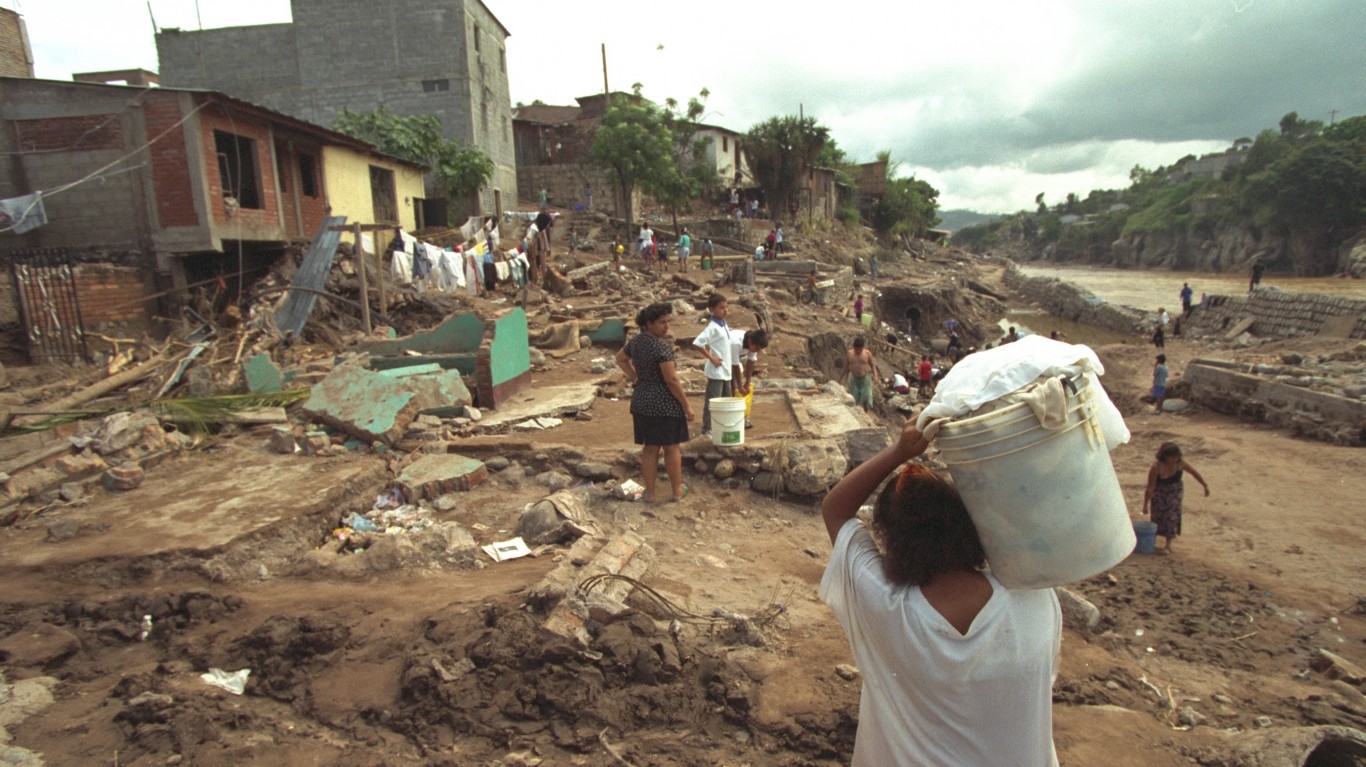
Honduras
> 2020 CO2 emissions: 10.63 million metric tons
> Share of global emissions: 0.03%
> Population: 9,904,610
Like many of the world’s poorest countries, Honduras is subject to some of the worst consequences of global warming. Heavily dependent on farming, the country saw 90% of its crops destroyed by Hurricane Mitch in 1998. Over 10,000 people died in the catastrophe, and the country’s progress suffered a severe setback, facing over $3 billion in damages.

Nicaragua
> 2020 CO2 emissions: 5.10 million metric tons
> Share of global emissions: 0.01%
> Population: 6,624,550
According to Germanwatch, Nicaragua was one of the three countries most affected by climate change in the 20 year period between 1992 and 2011, along with Honduras and Myanmar. Since then, the country has continued to be battered by hurricanes and punished with extreme heat, flooding, and droughts. Except for one other year in its history, temperatures in the last two decades have been the highest ever experienced, putting Nicaragua on track for heat that will make the country unlivable by 2070.
[in-text-ad-2]

Dominican Republic
> 2020 CO2 emissions: 29.09 million metric tons
> Share of global emissions: 0.08%
> Population: 10,847,900
With increasingly regular assaults from storms, flooding, and drought, the Dominican Republic averages 52 deaths a year from climate-related weather events. Flooding has been the most serious threat. Though the Caribbean islands are famously pummeled by hurricanes, the tourist industry is able to tout that the Dominican Republic is usually spared from major hurricane damage.
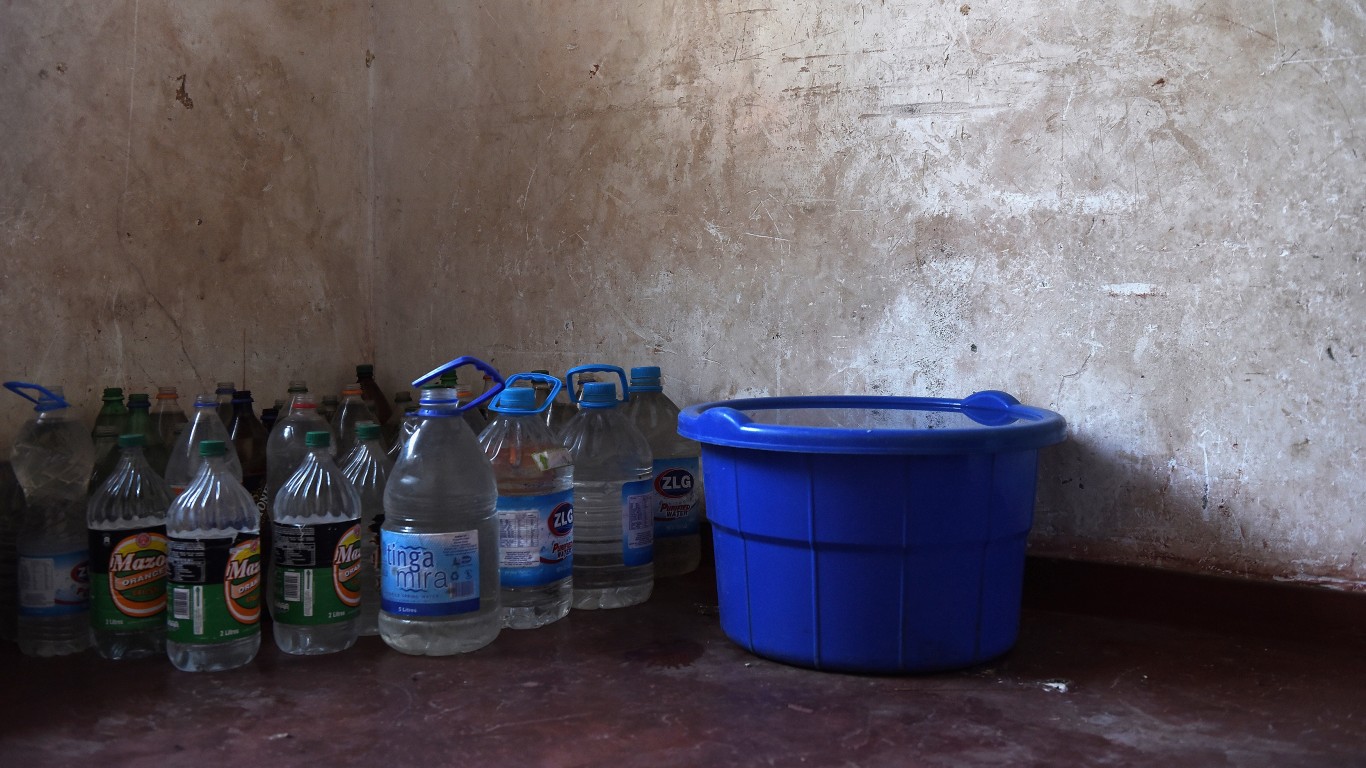
Zimbabwe
> 2020 CO2 emissions: 11.56 million metric tons
> Share of global emissions: 0.03%
> Population: 14,862,930
In 2019, Zimbabwe was one of three African countries hit hardest by Idai, a cyclone that brought 120 mph winds and torrential rain, causing extreme flooding and landslides. At least 340 people were killed and tens of thousands displaced. Hundreds of miles of road infrastructure were destroyed, impeding humanitarian response efforts.
[in-text-ad]
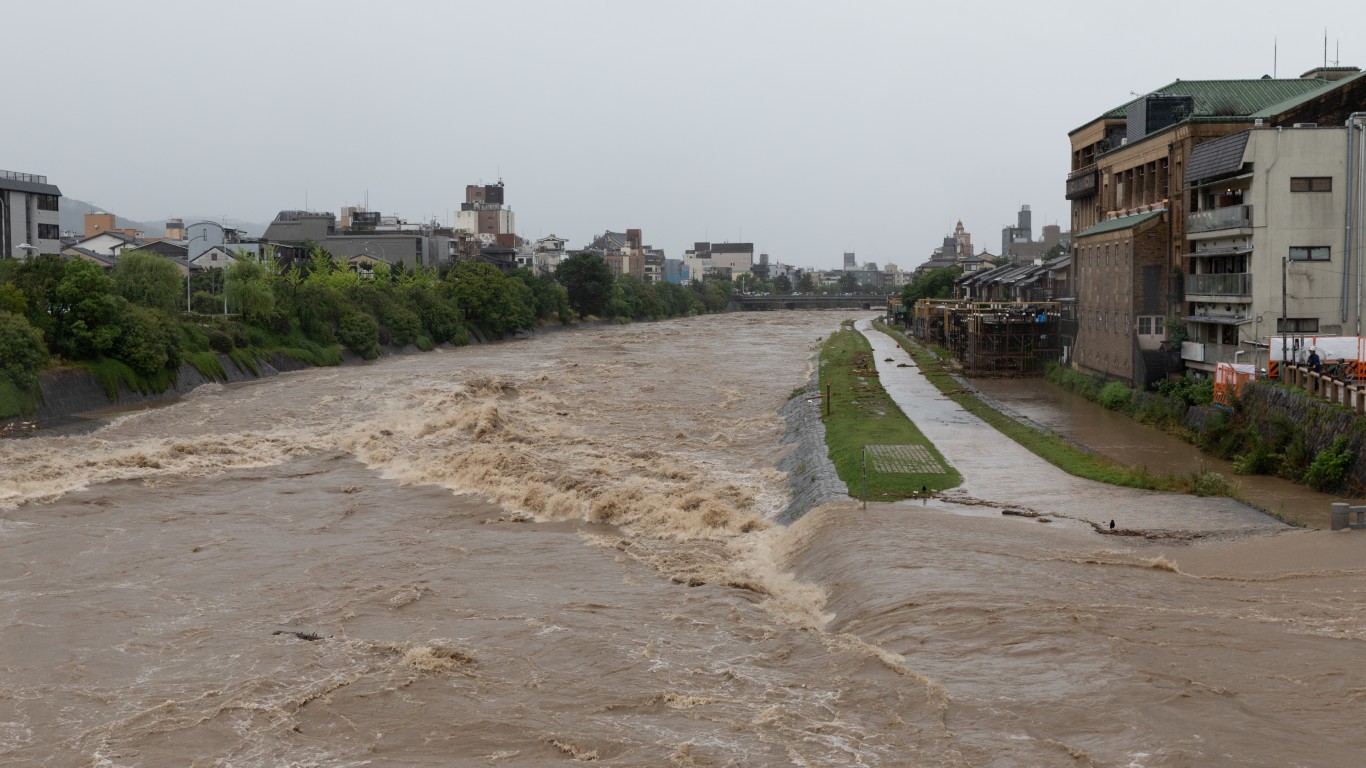
Japan
> 2020 CO2 emissions: 1,061.77 million metric ton
> Share of global emissions: 2.95%
> Population: 125,836,020
Climate change is bringing extreme temperatures and more frequent and dangerous storms to Japan. In 2018, the country suffered from deadly heat waves and torrential rains, killing hundreds and hospitalizing thousands. 2019 was worse. In May and August, Japan experienced two more killing heatwaves and two disastrous storms. In September, Typhoon Faxai made landfall near Tokyo, with winds of up to 130 mph, knocking out power to 900,000 households. In October, typhoon Hagibis arrived with the force of a Category 5 hurricane, killing 100 people and damaging 13,000 homes. The economic damage from the two storms totalled $25 billion.
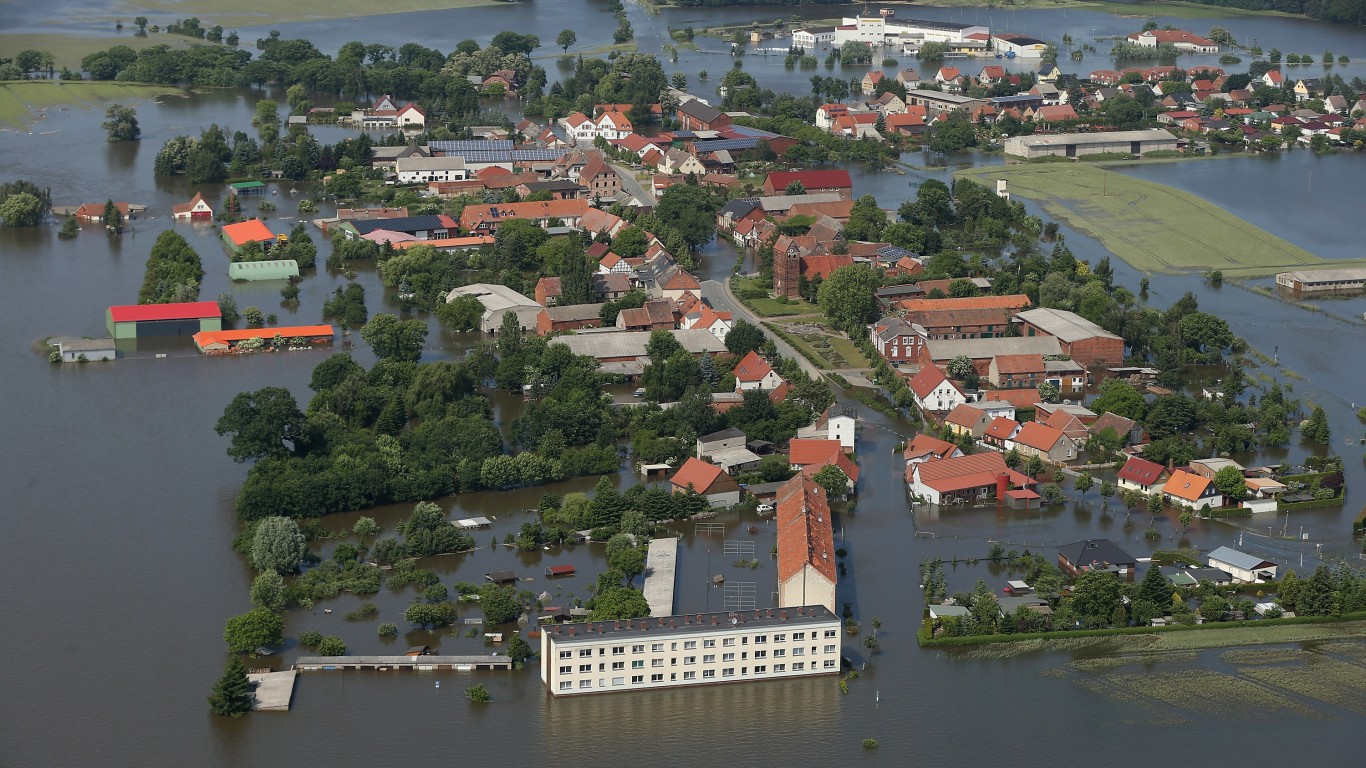
Germany
> 2020 CO2 emissions: 636.88 million metric tons
> Share of global emissions: 1.77%
> Population: 83,240,520
Climate change is credited with rising temperatures and interfering with precipitation patterns throughout Europe. In 2018, Germany experienced its hottest temperatures on record and only 60% of its usual summer rainfall after heavy rainfalls in January. An April to July heatwave killed 1,234 people, and farmers were left desperate as a result of drought, requiring $1.8 billion in aid.

Sri Lanka
> 2020 CO2 emissions: 23.73 million metric tons
> Share of global emissions: 0.07%
> Population: 21,919,000
The island nation of Sri Lanka is extremely vulnerable to climate change, particularly its critical agriculture sector. While only 30%-40% of farmers in Sri Lanka are aware of climate change, most farmers know that something is wrong. In recent decades, they have experienced increasingly worrying crop loss due to drought, flash flooding, and landslides brought on by shifting weather patterns and sea level rise.
[in-text-ad-2]
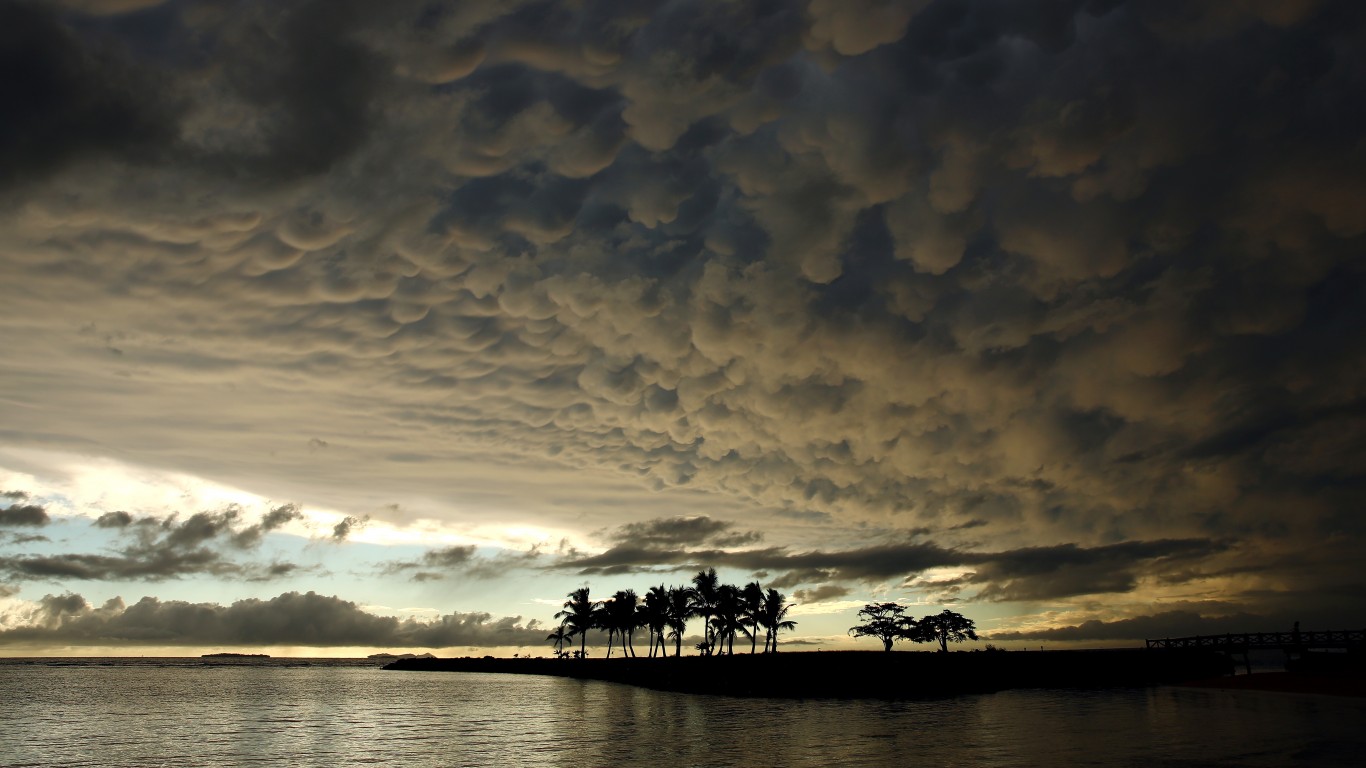
Fiji
> 2020 CO2 emissions: 2.38 million metric tons
> Share of global emissions: 0.01%
> Population: 896,440
Though its contribution to the climate change crisis is negligible, Fiji faces some of its most devastating consequences. The sea is rising faster than the global average, at a rate of 0.2 inches annually, eroding the shoreline, bringing saltwater inland, and ruining precious farmland. Increasing storms are also an immense problem. After three damaging cyclones struck the country in 2018, Fiji made the Germanwatch list of the 10 countries most affected by climate change for that year.
Methodology
To create a list of 20 countries most affected by climate change, 24/7 Wall St. reviewed reports from the annual Climate Risk Index, published annually by Germanwatch, an environmental organization that promotes global sustainability and equity. The CRI measures and analyzes the effects of climate from extreme weather events.
For each of the last 16 years, Germanwatch has listed the 10 countries and regions most affected by climate change, along with measures of the destruction, based on data available at the time, which is always two years previous to the year of its report. In 2020 and 2021, it also published lists of the most affected countries over the course of two decades: in 2021 the list covers the years 2010 to 2019, and in 2020 the list covers the years between 1999 and 2000. To be considered, all countries needed to be on the CRI multi-decade lists, or be among the most affected countries between 2016 and 2019.
Population data is from the World Bank and is for the most recent year available. CO2 emissions in million metric tons for 2020 per country as well as the share of world emissions came from the European Commission’s Database for Global Atmospheric Research.
Are You Still Paying With a Debit Card?
The average American spends $17,274 on debit cards a year, and it’s a HUGE mistake. First, debit cards don’t have the same fraud protections as credit cards. Once your money is gone, it’s gone. But more importantly you can actually get something back from this spending every time you swipe.
Issuers are handing out wild bonuses right now. With some you can earn up to 5% back on every purchase. That’s like getting a 5% discount on everything you buy!
Our top pick is kind of hard to imagine. Not only does it pay up to 5% back, it also includes a $200 cash back reward in the first six months, a 0% intro APR, and…. $0 annual fee. It’s quite literally free money for any one that uses a card regularly. Click here to learn more!
Flywheel Publishing has partnered with CardRatings to provide coverage of credit card products. Flywheel Publishing and CardRatings may receive a commission from card issuers.
Thank you for reading! Have some feedback for us?
Contact the 24/7 Wall St. editorial team.
 24/7 Wall St.
24/7 Wall St.


